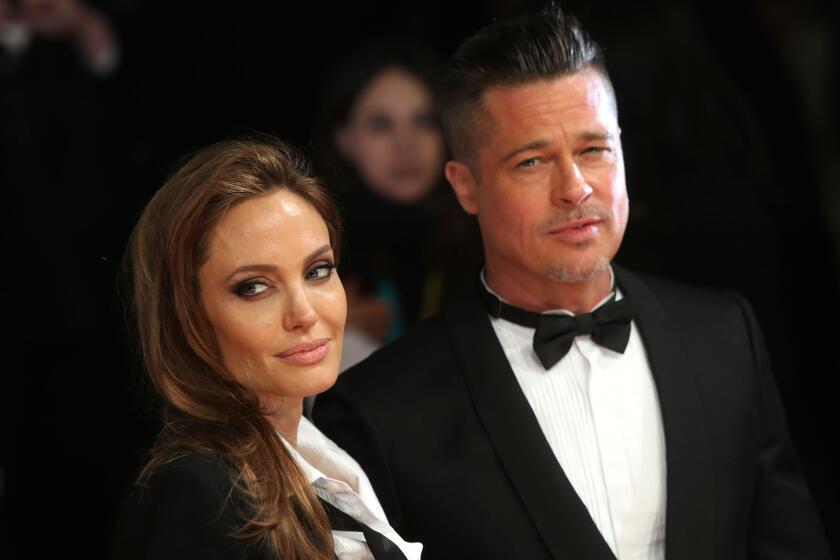THE MOVIES : CONFESSIONS OF A CLOSET CINEASTE
- Share via
The Times pop-music critic unveils his Conversion Chart. Here’s how it works: From his list, pick a movie that interests you. It’s teamed with a pop artist or specific album of parallel ambition or achievement. If you’re a fan of the musical act, you can bet you’ll like the film.
I grew up loving movies as much as rock ‘n’ roll, and I probably still spend almost as many hours in movie theaters as in clubs or concert halls. Yet, for years, movies and music seemed decidedly separate and unequal experiences.
It wasn’t simply a matter of different forms--the fact that movies were best enjoyed in a dark theater, while music was something you could take with you; something that was even more absorbing when heard on the car radio or at the beach.
Movies always seemed more important because they had such history and range. A movie meant entire crews : actors, directors, producers, screenwriters, set designers and, most important, 90 minutes to tell the story. All you needed to make an album of three-minute songs was a band, a producer and an engineer. The whole thing could be wrapped up in an afternoon.
The history of film was filled with such honored names as Griffith, Eisenstein, Chaplin, Welles, Hitchcock, Capra, Ford. There was no equivalent history to rock--and even the most optimistic fans didn’t think rock would last more than a few years. The closest thing you had to a giant in rock in the ‘50s was Dick Clark--and he wasn’t all that tall.
The biggest barrier to thinking of rock as an art form equal to motion pictures may simply have been the fact that everyone seemed to accept the proposition that rock was supposed to be fun, while the best movies were seen as serious, even socially significant.
It’s different now.
I still love movies, but rock has emerged as an equal art form. Paul Simon, Peter Gabriel, Bruce Springsteen, Prince, U2 and Sting are among the artists who bring as consistent insight and passion to their musical works as the most heralded film makers. Several of these artists, most notably Prince and Sting, have made or appeared in films themselves--though the quality of their film work is rarely as affecting as their music.
You need look no further for a symbol of the way the world of movies and music have merged than your neighborhood multiplex theater.
Offering audiences the choice of a dozen or more screens, these theaters serve as giant jukeboxes. The only difference is that you pay $6 instead of 25 cents and invest 90 minutes instead of three.
The fact is, I’ve got a better return in recent years on my quarters.
IF YOU ACCEPT THE suggestion that the vast majority of records and films are essentially worthless, a music fan can throw out 1,500 albums as hollow and calculated, yet still have hundreds left to choose from.
With movies, however, once you get past the dozens of cynical “Beverly Hills Cop II” variations and absurdly plotted “Suspect” clones, there isn’t a lot left--not if you’re a one- or two-movie-a-week addict.
That’s where our Conversion Chart can be helpful.
If you’re finding it increasingly difficult to find a movie with the character and intimacy you desire, certain albums may fill the void.
Here’s how the chart works: Find a movie that interests you from the cross-section below, both recommended films and some that have been simply widely discussed. Each film is matched with a pop artist or specific album of parallel ambition or achievement. The system can also work in reverse. If you’re a fan of one of the pop acts, you can bet you’ll like the film.
The conversion chart:
“Blue Velvet”-- A bold and unsettling juxtaposition of comforting images--blue skies, white picket fences--and violent, perverse impulses that are as dazzling visually and as provocative thematically.
Pop equivalent: Prince, especially the “1999” album.
“Broadcast News”-- Ads are often more accurate gauges of the quality and/or tone of a film than reviews. The pleasant smiles on the faces of William Hurt, Holly Hunter and Albert Brooks in the ads suggest a pleasant, entertaining film, but they don’t lead you to expect any irony or edge. And sure enough, the film is all gloss, though wonderfully entertaining gloss. The only way this satire on the politics of the TV newsroom--specifically, the advantage of pretty faces over competent reporters--can be considered biting or revealing is if you’ve never turned on a local newscast.
Pop equivalent: Lionel Richie, lots of accessibility and craft, but little innovation or commentary.
“Dirty Dancing”-- This is old-fashioned movie making dressed up with sensual dance sequences that distract you from how corny things really are.
Pop equivalent: Billy Joel, great at dressing up familiar pop concepts.
“Empire of the Sun”-- Spielberg, as much as anyone working in films, understands how to make an audience marvel, and the opening minutes of “Empire” set you up for a breathtaking excursion: the sudden uprooting of a boy from his safe, secure childhood, and the way he hustles his way through a World War II prison camp. But there is little focus or soul in the disjointed film. It is the art of movie making without the heart.
Pop equivalent: Michael Jackson’s “Bad” album, which lacks the vitality and pulse of either “Thriller” or the live show.
“Hope and Glory”-- John Boorman’s inspiring film celebrates a family’s use of the most unexpected circumstance (World War II London) to liberate themselves from the routine of their conventional lives. It’s a warm, embracing, yet never overly sentimental film.
Pop equivalent: John Hiatt’s “Bring the Family” album, a celebration of family values, and Paul Simon’s “Graceland” album, a celebration of cultural differences.
“The Last Emperor”-- This idea looks great on paper: A man of immense conceit who is eventually humbled and becomes a gardener in a country where, as a child, he was emperor. Bernardo Bertolucci frames the story in a slow, elegant manner that enables us to feel the isolation, weight and helplessness of Pu Yi’s plight. Yet, there is a lack of dramatic punch or pulse. Instead of helping us understand or identify with Pu Yi, Bertolucci keeps us at a distance, leaving us feeling that we have simply toured the Forbidden City rather than really met its fallen ruler.
Pop equivalent: Stevie Wonder’s “Journey Through the Secret Life of Plants,” a work of considerable ambition and detail, but limited accessibility.
“Moonstruck”-- A movie as warm and disarming as a neighborhood block party.
Pop equivalent: Los Lobos.
“The Promised Land”-- A splendid, sadly overlooked 1988 film about the explosive consequences of young people in an isolated Utah town coming to grips with their shattered dreams.
Pop equivalent: Bruce Springsteen’s “Nebraska” album.
“The River’s Edge”-- A powerful story of alienated teen-agers who grapple with matters of morality without the necessary support or foundation to do so. An unnerving glimpse of a breakdown in teen-parental relations in America today.
Pop equivalent: the Beastie Boys.
“She’s Gotta Have It”-- Spike Lee’s wry and witty salute to movie making and the vitality of urban street culture.
Pop equivalent: Run-D.M.C.
THE CONVERSION CHART isn’t meant to be simply a consumer guide. It’s also meant to underscore the relative equality of movies and music as art forms.
That observation is not solely a celebration of the artistic growth of rock but an acknowledgement of the difficulties that exist these days in making a wholly satisfying film.
Rock owes a major debt to Hollywood. The music’s earliest stars largely patterned their sensual, rebellious images after screen rebels, notably Marlon Brando in “The Wild One” and James Dean in “Rebel Without a Cause.”
What went unnoticed for years was that such rockers as Presley, Chuck Berry, Jerry Lee Lewis and Eddie Cochran became more convincing symbols of that youthful independence and aggression than the actors.
A Presley or Berry record or video from that era stands as a far more radical and representative work than the youth-oriented ‘50s movies--many of which are best enjoyed today as camp. Seen “Rebel Without a Cause” lately?
Rock, however, no longer speaks to the youth culture with the urgency and power that it did in the ‘60s--one reason why a surprising number of teen-agers today are more fascinated with the music of the ‘50s and ‘60s than of the ‘80s. But rock has grown in other ways.
The most challenging musicians have expanded their subject matter to cover a far wider sociological and psychological base than during the music’s youth-conscious beginnings. Despite its sociological impact over the last three decades, however, rock music is still perceived by much of the general public as offering fewer rewards than movies.
Many adult movie-goers, already discouraged in recent years by the film industry’s virtual genuflecting to the teen crowd, think of rock as yet something else designed chiefly for the young.
And it’s true: a great deal of rock is discouragingly shallow. But the same is true of films.
The rock world may point to the artistic sheen of such widely admired albums as Paul Simon’s “Graceland” and U2’s “The Joshua Tree,” but the norm is closer to the middle-brow Bon Jovi.
Similarly, the film community takes pride in such inspiring moments of brilliance and vision as John Boorman’s “Hope and Glory” and David Lynch’s “Blue Velvet.” More typical of the level of achievement of the average film, however, is the air-headed “Top Gun.”
The most disheartening failure of films isn’t clumsiness, but compromise, and both “serious” films and mere “entertainments” suffer from this race for box-office dollars.
More to Read
Only good movies
Get the Indie Focus newsletter, Mark Olsen's weekly guide to the world of cinema.
You may occasionally receive promotional content from the Los Angeles Times.










